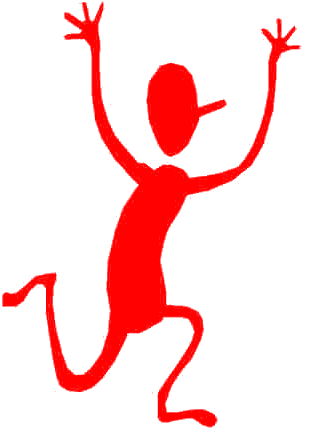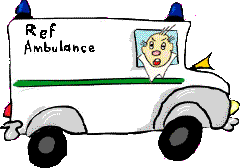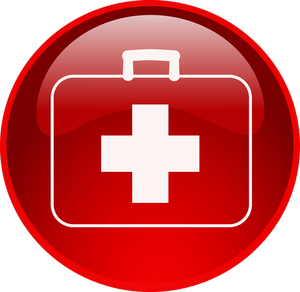| |
 |
EMERGENCY PLAN
Advice for 'ALL' Football/Soccer Referees
Andrew Castiglione
Founder of Ken Aston Referee Society
 |
" EMERGENCY PLAN "
Albeit that Referees’ are not directly
responsible for summoning medical help when a serious injury
occurs, if you are the only one with a mobile phone, and the
player is seriously injured, then football comes... second.
This advice does not assume that the Referee must take this
action. The responsibility for summoning help would normally lay
with the team trainers’, or if you are lucky, with a qualified
first-aider.
From a football team perspective, it is important that one
person should take responsibility for summoning help should an
emergency occur. Nowadays, a mobile phone is usually available
to contact medical help. If a mobile phone is not available, the
nearest telephone to the field of play must be used. When
arriving at the field of play, make a mental note of any
telephone kiosks in the vicinity. The home team players should
know where the nearest telephone is. |
 |
Although serious injuries in football are thankfully low compared to the
number of games played, they do occur from time to time. Especially
during England’s winter, when slippery and hard surfaces will increase
the likelihood of a serious injury occurring. The question is - do the
players (or do you the Referee, as a last resort) know how to summon
help properly in an emergency?
CALLING FOR AN AMBULANCE:
The 911 OR 999 systems was introduced in 1973 by some countries
for dealing with urgent calls from anyone who needed help from the
Police, Fire or Ambulance services. It was gradually extended to cover
the entire world but it was not until the late 1980s that the facility
was available from every telephone.
On average, most people will only dial 911 OR 999 once in their lives.
Subsequently it can be a daunting process, particularly as the need to
use the emergency service is always associated with an urgent need for
assistance. Remember this service
is... FREE: You do not need to put money into a payphone to
use it and the ambulance service will never charge you for attending an
incident.
Please remember, if you think you might need to dial 911 OR 999 but are
not sure, then you do need to dial 911 OR 999 and ask for advice. This
is not considered to be a hoax call or a waste of time. There are still
cases where people have failed to dial 911 or 999 because they 'did not
want to bother anyone' and patients have suffered as a result. The
ambulance service is there to help!
WHAT WILL HAPPEN WHEN YOU CALL
911 OR 999?
You will firstly be connected to a 911
or 999 TELECOMMUNICATIONS OPERATOR who will be based in one of
the emergency call centers in the WORLD (unless using a mobile phone -
some mobile telephone companies have their own 911 OR 999 operators).
They will ask for your name, the telephone number you are calling from,
and which emergency service you require. Your calling number is normally
automatically displayed, but the operator may ask you to confirm the
telephone number from which you are calling. It is not yet possible to
pinpoint a mobile telephone number location, so be prepared to give
detailed directions. All these details are entered onto a computerized
logging system so it helps if you speak clearly and steadily.
Precise directions, including any landmarks in rural locations can be of
great assistance in ensuring help gets to you as soon as possible.
The operator will then connect you to the most appropriate
AMBULANCE CONTROL CENTER or FIRE DEPARTMENT for the
area you are calling from. The operator will pass on your caller number
to the Ambulance Control. It is important that you stay quiet at this
stage to avoid confusion, but it ensures that if you get cut off, the
ambulance service can ring you back with the minimum of delay.
"BETTER... SAFE - THEN... SORRY...
 "
"
The Ambulance Control or Fire Department Staff will then ask you the following questions:
1. What is the exact
LOCATION of the incident?
2. What is the PHONE NUMBER you are calling from?
3. What is the PROBLEM (Tell
them EXACTLY what happened)?
4. (If not obvious) How
MANY people are
HURT or
SICK?
5. How OLD is the patient?
6. Is the patient
CONSCIOUS?
7. Is the patient
BREATHING?
8. Is the patient
MALE or
FEMALE? |
 |
You may be asked more specific questions depending on the answers you
have already given, and will be given FIRST AID ADVICE if it is
required. Answering these questions does not delay ambulance response in
any way. The questioning is done to ascertain the patient's most
significant medical problem.
For example, a patient with serious bleeding or who is unconscious is
more likely to need immediate treatment than a player with a suspected
broken leg is.
Whilst the call is ongoing, the information is relayed electronically by
the computer to a ‘Mobilizer’ who will send the nearest available
ambulance crew to you. Only hang up after the operator instructs you
that they have all the information needed. If the patient’s condition is
serious, the operator may wish to stay on the line with you until the
ambulance arrives. (For example, if you may be required (or need advice)
to give the patient Cardio-Pulmonary Resuscitation (CPR) chest
compressions and mouth-to-mouth resuscitation.
A quick note on... SHOCK!
When considering the severity of any serious injury, be aware of the
casualty suffering from ‘SHOCK’
as a result of the trauma of the injury. Always try and make the
casualty comfortable and keep them warm and dry when the weather is cold
or wet.
The body reacts to traumatic shock by directing more blood to the
arteries supplying the vital organs (e.g. brain heart and kidneys) at
the expense of those supplying the less important tissue (e.g. muscle
and skin). Symptoms of shock include, feeling weak, faint, giddy anxious
and restless. Casualty may vomit; feel thirsty, breath shallow and
rapidly inducing yawning and sighing. Skin becomes pale or gray in color
(particularly the lips), cold and moist with sweat. Pulse increases and
but becomes weaker and sometimes irregular as the blood/fluid drops.
Unconsciousness may develop. There may be evidence of associated
external or internal injury. First aid treatment involves reassuring the
casualty, keeping the head low by lying down and turning the head to one
side to increase blood to the brain and lessen the dangers of vomiting.
Do not unduly move the patient. The legs should be raised - but not if a
leg is fractured. Keep warm but do not apply a hot water bottle. Loosen
any tight clothing. Do not have anything to drink (this will delay any
subsequent administration of anesthetic for emergency treatment to any
serious injury) - but the lips can be moistened.
NO SMOKING ALLOWED... PERIOD!!!
Shock can materialize many hours after the incident, so look out for any
of these symptoms. Seek medical attention immediately.
SHOCK CAN... KILL
This web site and the advice and answers
to any questions are not sanctioned by or affiliated with any governing
body of soccer. The opinions expressed on this site should not be
considered official interpretations of the Laws of the Game. Although
the content of the latest Laws are included on this site, the majority
of the content is the opinion of the Webmaster and other Referees
worldwide. If you need an official ruling you should contact your local
representative or visit the FIFA, or the English FA web sites for the
Laws themselves.
|